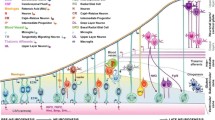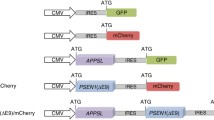Abstract
The ability to model brain tissue in three-dimensions offers new potential for elucidating functional cellular interactions and corruption of such functions during pathogenesis. Many protocols now exist for growing neurones in three-dimensions and these vary in complexity and cost. Herein, we describe a straight-forward method for generating three-dimensional, terminally differentiated central nervous system cultures from adult murine neural stem cells. The protocol requires no specialist equipment, is not labour intensive or expensive and produces mature cultures within 10 days that can survive beyond a month. Populations of functional glutamatergic neurones could be identified within cultures. Additionally, the three dimensional neuronal cultures can be used to investigate tissue changes during the development of neurodegenerative disease where demonstration of hallmark features, such as plaque generation, has not previously been possible using two-dimensional cultures of neuronal cells. Using a prion model of acquired neurodegenerative disease, biochemical changes indicative of prion pathology were induced within 2–3 weeks in the three dimensional cultures. Our findings show that tissue differentiated in this simplified three dimensional culture model is physiologically competent to model central nervous system cellular behaviour as well as manifest the functional failures and pathological changes associated with neurodegenerative disease.







Similar content being viewed by others
References
Bard, J., & Elsdale, T. (1986). Growth regulation in multilayered cultures of human diploid fibroblasts: The roles of contact, movement and matrix production. Cell and Tissue Kinetics, 19(2), 141–154.
Bellamkonda, R., et al. (1995). Hydrogel-based three-dimensional matrix for neural cells. Journal of Biomedical Materials Research, 29(5), 663–671.
Justice, B. A., Badr, N. A., & Felder, R. A. (2009). 3D cell culture opens new dimensions in cell-based assays. Drug Discovery Today, 14(1–2), 102–107.
Haston, K. M., & Finkbeiner S. (2016). Clinical trials in a dish: The potential of pluripotent stem cells to develop therapies for neurodegenerative diseases. Annual Review of Pharmacology and Toxicology, 56, 489–510.
Lai, Y., Cheng, K., & Kisaalita, W. (2012). Three dimensional neuronal cell cultures more accurately model voltage gated calcium channel functionality in freshly dissected nerve tissue. PLoS One, 7(9), e45074.
Pasca, A. M., et al. (2015). Functional cortical neurons and astrocytes from human pluripotent stem cells in 3D culture. Nature Methods, 12(7), 671–678.
Terrasso, A. P., et al. (2015). Novel scalable 3D cell based model for in vitro neurotoxicity testing: Combining human differentiated neurospheres with gene expression and functional endpoints. Journal of Biotechnology, 205, 82–92.
Emsley, J. G., et al. (2005). Adult neurogenesis and repair of the adult CNS with neural progenitors, precursors, and stem cells. Progress in Neurobiology, 75(5), 321–341.
Kitabatake, Y., et al. (2007). Adult neurogenesis and hippocampal memory function: new cells, more plasticity, new memories? Neurosurgery Clinics of North America, 18(1), 105–113. x.
Lugert, S., et al. (2010). Quiescent and active hippocampal neural stem cells with distinct morphologies respond selectively to physiological and pathological stimuli and aging. Cell Stem Cell, 6(5), 445–456.
Wang, Y. Z., et al. (2011). Concise review: Quiescent and active states of endogenous adult neural stem cells: Identification and characterization. Stem Cells, 29(6), 907–912.
Ahlenius, H., & Kokaia, Z. (2010). Isolation and generation of neurosphere cultures from embryonic and adult mouse brain. Methods in Molecular Biology, 633, 241–252.
Bosi, S., et al. (2015). From 2D to 3D: novel nanostructured scaffolds to investigate signalling in reconstructed neuronal networks. Scientific Reports, 5, 9562.
Lu, H. F., et al. (2012). Efficient neuronal differentiation and maturation of human pluripotent stem cells encapsulated in 3D microfibrous scaffolds. Biomaterials, 33(36), 9179–9187.
Lancaster, M. A., & Knoblich, J. A. (2014). Generation of cerebral organoids from human pluripotent stem cells. Nature Protocols, 9(10), 2329–2340.
Labour, M. N., et al. (2016). 3D compartmented model to study the neurite-related toxicity of Abeta aggregates included in collagen gels of adaptable porosity. Acta Biomater, 37, 38–49.
Anene-Nzelu, C. G., et al. (2013). Scalable alignment of three-dimensional cellular constructs in a microfluidic chip. Lab on a Chip, 13(20), 4124–4133.
Moreno, E. L., et al. (2015). Differentiation of neuroepithelial stem cells into functional dopaminergic neurons in 3D microfluidic cell culture. Lab on a Chip, 15(11), 2419–2428.
Seidel, D., et al. (2012). Induced tauopathy in a novel 3D-culture model mediates neurodegenerative processes: A real-time study on biochips. PLoS One, 7(11), e49150.
Haigh, C. L., et al. (2011). Acute exposure to prion infection induces transient oxidative stress progressing to be cumulatively deleterious with chronic propagation in vitro. Free Radical Biology & Medicine, 51(3), 594–608.
Collins, S. J., et al. (2015). The prion protein regulates beta-amyloid mediated self-renewal of neural stem cells in vitro. Stem Cell Research & Therapy, 6(1), 60.
Sinclair, L., et al. (2013). Cytosolic caspases mediate mislocalised SOD2 depletion in an in vitro model of chronic prion infection. Disease Models & Mechanisms, 6(4), 952–963.
Lawson, V. A., et al. (2008). Mouse-adapted sporadic human Creutzfeldt-Jakob disease prions propagate in cell culture. The International Journal of Biochemistry & Cell Biology, 40(12), 2793–2801.
Haigh, C. L., McGlade, A. R., & Collins, S. J. (2015). MEK1 transduces the prion protein N2 fragment antioxidant effects. Cellular and Molecular Life Sciences : CMLS, 72(8), 1613–1629.
Schindelin, J., et al. (2012). Fiji: An open-source platform for biological-image analysis. Nature Methods, 9(7), 676–682.
Lawson, V. A., et al. (2010). Near-infrared fluorescence imaging of apoptotic neuronal cell death in a live animal model of prion disease. ACS Chemical Neuroscience, 1(11), 720–727.
Brazier, M. W., et al. (2006). Correlative studies support lipid peroxidation is linked to PrP(res) propagation as an early primary pathogenic event in prion disease. Brain Research Bulletin, 68(5), 346–354.
Choi, S. H., et al. (2014). A three-dimensional human neural cell culture model of Alzheimer’s disease. Nature, 515(7526), 274–278.
Herva, M. E., et al. (2010). Prion infection of differentiated neurospheres. Journal of Neuroscience Methods, 188(2), 270–275.
Milhavet, O., et al. (2006). Neural stem cell model for prion propagation. Stem Cells, 24(10), 2284–2291.
Jones, E. V., & Bouvier, D. S. (2014). Astrocyte-secreted matricellular proteins in CNS remodelling during development and disease. Neural Plasticity, 2014, 321209.
Marella, M., & Chabry, J. (2004). Neurons and astrocytes respond to prion infection by inducing microglia recruitment. The Journal of Neuroscience, 24(3), 620–627.
Brown, D. R. (2001). Microglia and prion disease. Microscopy Research and Technique, 54(2), 71–80.
Liberski, P. P., & Brown, P. (2004). Astrocytes in transmissible spongiform encephalopathies (prion diseases). Folia neuropathologica / Association of Polish Neuropathologists and Medical Research Centre, Polish Academy of Sciences, 42(Suppl B), 71–88.
Takuma, K., Baba, A., & Matsuda, T. (2004). Astrocyte apoptosis: implications for neuroprotection. Progress in Neurobiology, 72(2), 111–127.
Szydlowska, K., Zawadzka, M., & Kaminska, B. (2006). Neuroprotectant FK506 inhibits glutamate-induced apoptosis of astrocytes in vitro and in vivo. Journal of Neurochemistry, 99(3), 965–975.
Saas, P., et al. (1999). CD95 (Fas/Apo-1) as a receptor governing astrocyte apoptotic or inflammatory responses: A key role in brain inflammation? Journal of Immunology, 162(4), 2326–2333.
Diedrich, J. F., et al. (1991). Scrapie-associated prion protein accumulates in astrocytes during scrapie infection. Proceedings of the National Academy of Sciences of the United States of America, 88(2), 375–379.
Andreoletti, O., et al. (2002). Astrocytes accumulate 4-hydroxynonenal adducts in murine scrapie and human Creutzfeldt-Jakob disease. Neurobiology of Disease, 11(3), 386–393.
Drew, S. C., et al. (2011). Optical imaging detects apoptosis in the brain and peripheral organs of prion-infected mice. Journal of Neuropathology and Experimental Neurology, 70(2), 143–150.
Meyer, R. K., et al. (1986). Separation and properties of cellular and scrapie prion proteins. Proceedings of the National Academy of Sciences of the United States of America, 83(8), 2310–2314.
Muramoto, T., et al. (1992). The sequential development of abnormal prion protein accumulation in mice with Creutzfeldt-Jakob disease. The American Journal of Pathology, 140(6), 1411–1420.
Acknowledgments
This work was funded by an NHMRC programme grant (SJC, #628946) and an NHMRC project grant (CLH, #APP1044264). SJC is supported by an NHMRC Practitioner Fellowship (#APP100581) and CLH is supported by a CJDSGN Memorial Grant in memory of Rhonda McCoy and the many people affected by prion disease in Australia.
Author information
Authors and Affiliations
Corresponding author
Ethics declarations
Compliance with Ethical Standards
NSCs were harvested as approved by the University of Melbourne animal ethics committee (ID 1011746), in compliance with Australian code of practice for the care and use of animals for scientific purposes.
Conflict of Interest
The authors declare that they have no competing interests.
Electronic supplementary material
Rights and permissions
About this article
Cite this article
Collins, S.J., Haigh, C.L. Simplified Murine 3D Neuronal Cultures for Investigating Neuronal Activity and Neurodegeneration. Cell Biochem Biophys 75, 3–13 (2017). https://doi.org/10.1007/s12013-016-0768-z
Received:
Accepted:
Published:
Issue Date:
DOI: https://doi.org/10.1007/s12013-016-0768-z




